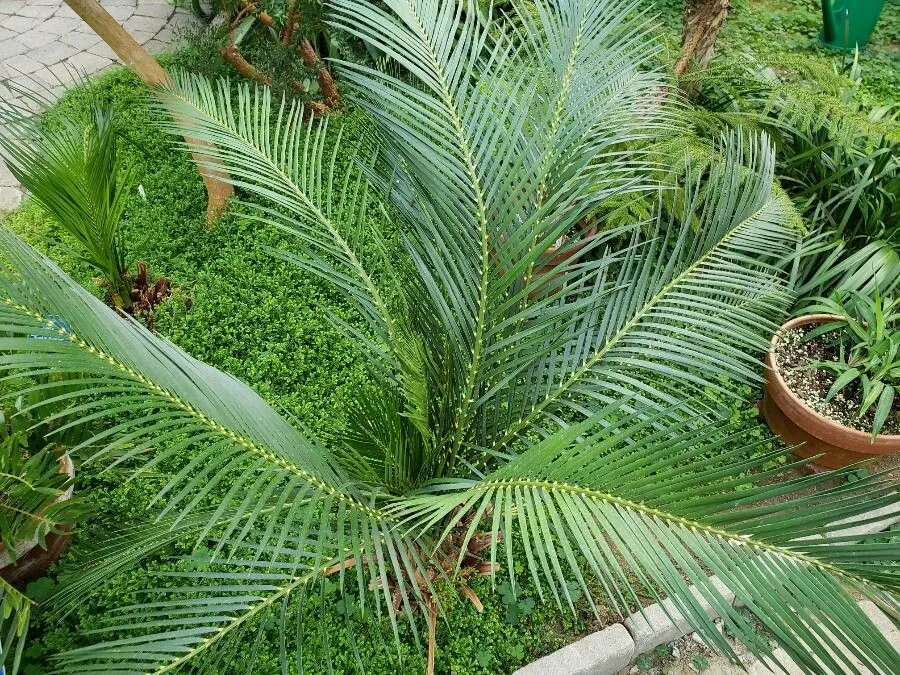
Author: L.A.S.Johnson
Bibliography: Proc. Linn. Soc. New South Wales 84: 98 (1959)
Year: 1959
Status: accepted
Rank: species
Genus: Macrozamia
Vegetable: False
Observations: CE. & SE. New South Wales
The Burrawong, scientifically known as Macrozamia communis, is a distinctive member of the Zamiaceae family. This plant species was first documented by L.A.S. Johnson in a publication detailed in the Proceedings of the Linnean Society of New South Wales in 1959. Found predominantly in central eastern and southeastern regions of New South Wales, Australia, the Burrawong thrives in these locales’ unique ecological settings.
Macrozamia communis is a cycad, a type of ancient seed plant with a fossil record tracing back to the age of dinosaurs. Characterized by its robust, sago palm-like appearance, the Burrawong features a sturdy trunk and an impressive crown of pinnate leaves. These leaves are dark green and glossy, often forming an elegant display that can reach considerable lengths. The plant’s rigid, spiny leaflets are arranged symmetrically along a central stem, creating a feathery look that is both striking and functional in its natural habitat.
One of the intriguing aspects of the Burrawong is its reproductive strategy. Like other cycads, Macrozamia communis is dioecious, meaning individual plants are either male or female. The reproductive structures are cone-like, with male plants producing pollen cones and female plants yielding seed cones. The seeds themselves are often large, coated in a fleshy layer that can be toxic if ingested without proper preparation—a fact that Indigenous Australians have long been aware of, traditionally processing these seeds to remove toxins before consumption.
Adapted to a variety of soil types, from sandy to loamy textures, and often found in open forests or woodlands, the Burrawong is a resilient plant, able to withstand periods of drought with its deep-root system designed to tap into subterranean water sources. This adaptation plays a crucial role in its survival in the diverse climate conditions of New South Wales.
While the Burrawong is typically slow-growing, it can become quite long-lived, making it an excellent subject for both conservation efforts and study in plant longevity. Its striking appearance and ecological resilience underscore the importance of preserving native habitats to ensure the continued survival of this remarkable species in its natural environment.
Eng: burrawong
En: Burrawong
Taken Mar 22, 2022 by Salome Hubin (cc-by-sa)
Taken Jul 25, 2022 by Michal Svit (cc-by-sa)
Taken Aug 2, 2011 by Daniel Barthelemy (cc-by-sa)
Taken Oct 31, 2022 by emma7484 (cc-by-sa)
Taken Feb 2, 2021 by ghislaine marino (cc-by-sa)
Taken Nov 7, 2020 by Maarten Vanhove (cc-by-sa)
Taken Jan 10, 2022 by William Coville (cc-by-sa)
Taken Jul 28, 2022 by Kai Best (cc-by-sa)
Taken Apr 27, 2019 by Pierre Bonnet (cc-by-sa)
Taken Apr 27, 2019 by Pierre Bonnet (cc-by-sa)
Taken Nov 13, 2022 by Nathalie Potel (cc-by-sa)
Taken Jul 28, 2022 by Kai Best (cc-by-sa)
Taken Aug 13, 2020 by André Hyvrier (cc-by-sa)
Taken Apr 27, 2019 by Pierre Bonnet (cc-by-sa)
Taken Nov 19, 2022 by Paul Harley (cc-by-sa)
Family: Myrtaceae Author: (F.Muell.) K.D.Hill & L.A.S.Johnson Bibliography: Telopea 6: 402 (1995) Year: 1995 Status:…
Family: Rubiaceae Author: Pierre ex A.Froehner Bibliography: Notizbl. Bot. Gart. Berlin-Dahlem 1: 237 (1897) Year:…
Family: Sapindaceae Author: Koidz. Bibliography: J. Coll. Sci. Imp. Univ. Tokyo 32(1): 38 (1911) Year:…
Family: Asteraceae Author: A.Gray Bibliography: Pacif. Railr. Rep.: 107 (1857) Year: 1857 Status: accepted Rank:…
Family: Fabaceae Author: Medik. Bibliography: Vorles. Churpfälz. Phys.-Ökon. Ges. 2: 398 (1787) Year: 1787 Status:…
Family: Aspleniaceae Author: (Cav.) Alston Bibliography: Bull. Misc. Inform. Kew 1932: 309 (1932) Year: 1932…